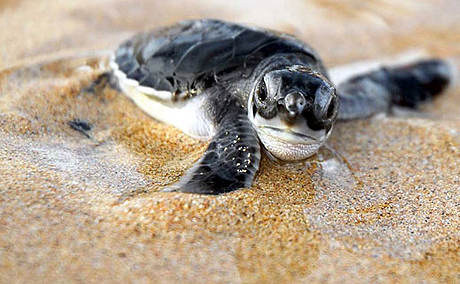 This interesting article is a reblog from my Daily Curio. Nearly 90% of sea turtle nesting in the U.S. occurs in Florida. The nesting season runs from May through October where most of the turtles return to their home beaches to lay eggs. Although, some species will come ashore as early as March.
This interesting article is a reblog from my Daily Curio. Nearly 90% of sea turtle nesting in the U.S. occurs in Florida. The nesting season runs from May through October where most of the turtles return to their home beaches to lay eggs. Although, some species will come ashore as early as March.
Turtles deposit approximately 100 golf-ball size eggs, and gently cover the eggs with sand and then they spread sand over a wide area to obscure the exact location of the chamber. They then leave the nest site and re-enter the water never to attend to their hatchlings again.
Climate change is having an unintended consequence affecting the gender of sea turtles. Sadly, this phenomenon could affect the future survival of the species. In a recent study from Current Biology, scientists found that in major breeding areas along The Great Barrier Reef, warming sands are causing over 99% of green sea turtles to be born female. A sea turtle’s gender is determined by the temperature of the sand where the egg incubates. At around 85º F, a clutch of turtles will be about 50/50 male and female. But if it’s slightly cooler, they skew male; slightly warmer and they skew female. The Current Biology study looked at a population of 200,000 turtles in the nesting area of Raine Island in northern Australia. They discovered that 99.1% of juveniles, 99.8% of subadults, and 86.8% of the entire population were female. Populations in southern Australia fared better, since beaches there are cooler, with 65% to 69% females. When the biologists combined their results with temperature data in the area, they concluded that these green turtle rookeries have likely been producing predominantly female populations for two decades. Since the animals don’t reach breeding age until 25 or 30, it means disaster could be right around the corner. What’s more, scientists have long looked at sea turtle populations to predict trouble for other heartier species. Sometimes called the “lawn mowers of the ocean,” sea turtles maintain coral reefs and transport their nutrients for other marine animals. Not all the news about turtles is grim. A study from last year showed many of the planet’s seven species of sea turtle are increasing in population. But where those populations will thrive is another question.
More info related visit: Sea Turtle Conservancy, a non-profit group based in Gainsville, Florida. https://conserveturtles.org/information-sea-turtles-threats-climate-change/
Contributed by: Martin J. Allred
http://www.Floridaography.com
Share this:




